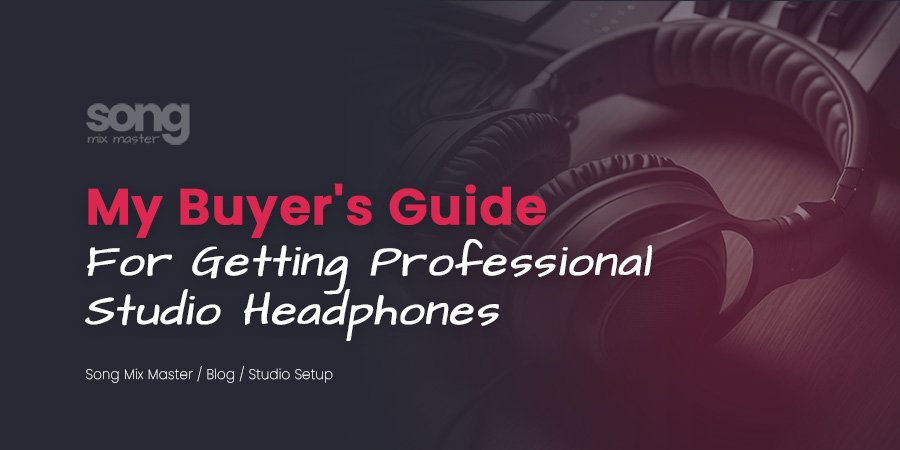Studio Setup, Tutorials
My Buyer’s Guide for Professional Studio Headphones
Choosing the right studio headphones is crucial for any serious music producer, mastering, or mixing engineer. The right pair of headphones can make a significant difference in your work by providing accurate sound reproduction, comfort for long sessions, and features tailored to your specific needs. Here’s my in-depth guide to help you make an informed decision.
Tips for Choosing Studio Headphones
1. Comfort
Long studio sessions are common, so ensure your headphones fit comfortably. Look for models with padded ear cups and adjustable headbands to prevent fatigue during extended use. Lightweight designs can also significantly enhance comfort, allowing for longer, uninterrupted work sessions without discomfort.
2. Open or Closed
Closed-back Headphones: Closed-back headphones are perfect for recording sessions because they provide excellent noise isolation. This prevents sound from leaking out and being picked up by the microphone, ensuring a clean recording without unwanted external noise.
The sealed design of closed-back headphones helps block out external sounds, making them ideal for use in noisy environments. This allows you to focus on your audio without distractions.
Closed-back headphones create a more intimate listening experience by keeping the sound directed into your ears. This can be useful for detailed editing and monitoring.
Open-back Headphones: Open-back headphones offer a more natural and spacious sound, which is crucial for mixing and mastering. The open design allows air and sound to pass through the ear cups, providing a more accurate and realistic representation of your audio.
Open-back headphones create a wider soundstage, giving you a sense of space and depth in your music. This helps in making more informed decisions about panning, reverb, and overall balance in your mix.
Also see: 5 Tips for Using The Reverb Effect in Music Production
Because open-back headphones do not create a sealed environment around your ears, they tend to be less fatiguing during long sessions. The natural airflow keeps your ears cool and comfortable.
By considering your specific needs, whether it’s recording, mixing, or mastering, you can choose the type of headphones that will best support your work.
For recording, closed-back headphones are the preferred choice due to their noise-isolation capabilities. For mixing and mastering, open-back headphones are better suited, offering a natural sound and a wider soundstage.
3. Impedance
Impedance measures the resistance of the headphones. Higher impedance headphones (e.g., 250 Ohms and above) generally provide better sound quality but may require a powerful amplifier to drive them effectively. Lower impedance headphones (e.g., 32 Ohms) are easier to drive and can be used with portable devices without an external amp.
4. Sound Quality
Look for headphones that offer a neutral and flat frequency response. This ensures that you hear your mix accurately without any coloration, allowing you to make precise adjustments. Avoid headphones that artificially boost bass or treble, as these can mislead your mixing decisions.
Where to Buy Studio Headphones
You can purchase studio headphones directly from manufacturer websites or music specialty stores. One of the most trusted retailers is Thomann, Europe’s largest music retailer, known for its extensive range of studio equipment and competitive prices. Other reputable online stores include Sweetwater, Guitar Center, and Amazon.
FAQs About Studio Headphones:
Closed-back Headphones: Ideal for recording due to their noise isolation capabilities, which prevent sound leakage and external noise interference.
Open-back Headphones: Better for mixing and mastering, offering a natural sound and a wider soundstage for more accurate audio representation.
Impedance affects how much power your headphones need. Higher-impedance headphones often provide better sound quality but may require a dedicated amplifier. Lower-impedance headphones are easier to drive and more versatile for use with various devices.
This depends on the impedance of your headphones. High-impedance headphones (>100 Ohms) typically benefit from an amplifier to achieve optimal performance and sound quality.
Yes, but they are designed for a neutral sound, which may not be as exciting as consumer headphones that boost the bass and treble. Additionally, studio headphones are often larger and have longer cables, making them less portable.
Absolutely. Many professional engineers use studio headphones for detailed work, especially in environments with poor acoustics. They allow for precise adjustments and help ensure that your mix translates well across different playback systems.
Final Thoughts
Investing in a high-quality pair of studio headphones is essential for any serious music production work. With the right knowledge and equipment, you’re well-equipped to bring your musical visions to life.
Don’t hesitate to invest in quality, it’s worth it!


Disclaimer: Any references to any brands on this website/webpage, including reference to products, trademarks, brands and companies, are provided for description purposes only. We don't have any association with or endorsement by these brands or companies. Some of the links on our blog may be affiliate links. This means if you click on these links and make a purchase, we may earn a commission at no extra cost to you.
Need Professional Mixing & Mastering?
You may also like to read...
How to Make FL Studio Run Faster on Your Computer
Soft Clipping vs. Hard Clipping: Achieving Natural Sound Distortion
What is The Knee Control in Audio Compression?
The Rise of DIY Music: How Independent Artists Can Thrive
My Advanced Techniques & Tips for Mixing and Mastering
Top 10 Tips for Preparing Your Tracks for Mixing and Mastering